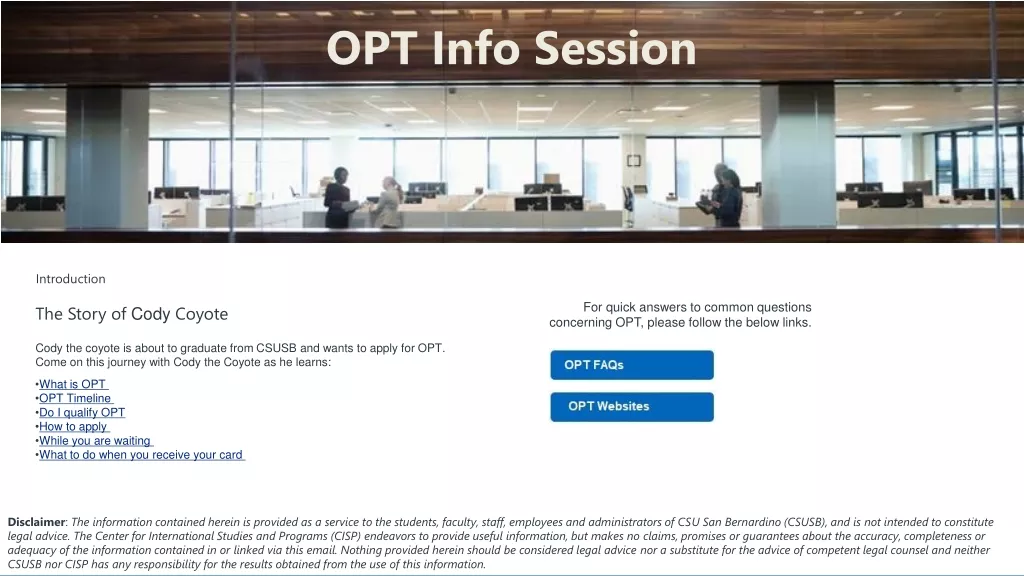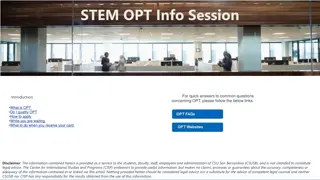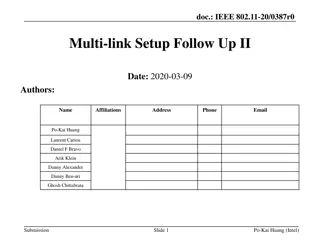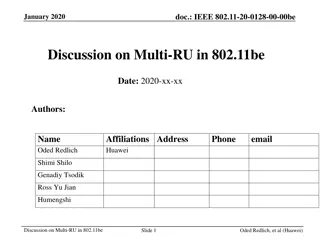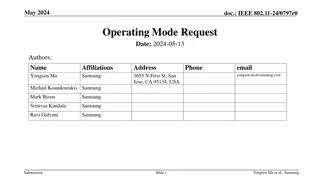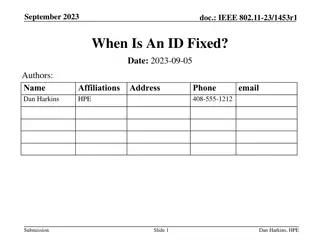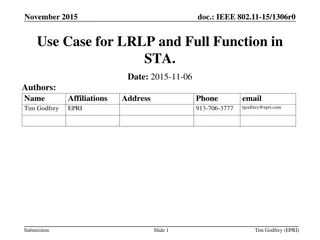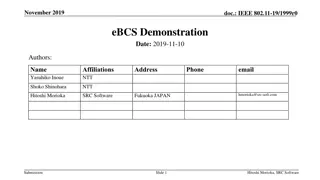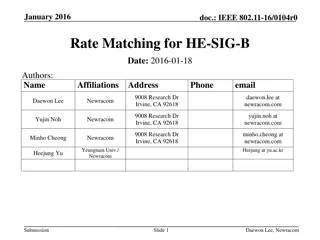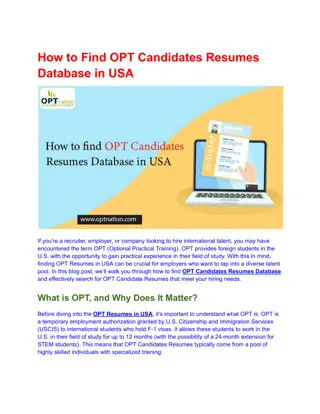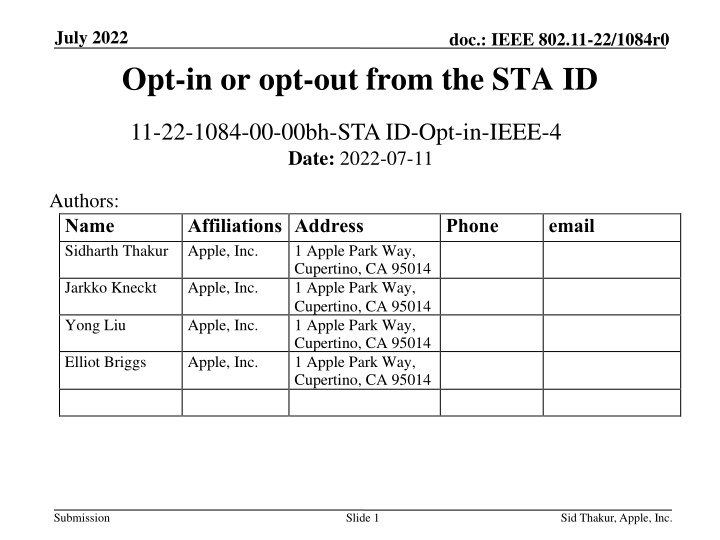
IEEE 802.11-22/1084r0 Opt-In for Network Identification
"Learn about the proposal for IEEE 802.11bh allowing devices to opt-in or opt-out from unique network identification, addressing user consent and signaling mechanisms within the MAC-layer. Explore the implications for compliance with regulations like GDPR."
Download Presentation

Please find below an Image/Link to download the presentation.
The content on the website is provided AS IS for your information and personal use only. It may not be sold, licensed, or shared on other websites without obtaining consent from the author. If you encounter any issues during the download, it is possible that the publisher has removed the file from their server.
You are allowed to download the files provided on this website for personal or commercial use, subject to the condition that they are used lawfully. All files are the property of their respective owners.
The content on the website is provided AS IS for your information and personal use only. It may not be sold, licensed, or shared on other websites without obtaining consent from the author.
E N D
Presentation Transcript
July 2022 doc.: IEEE 802.11-22/1084r0 Opt-in or opt-out from the STA ID 11-22-1084-00-00bh-STA ID-Opt-in-IEEE-4 Date: 2022-07-11 Authors: Name Sidharth Thakur Affiliations Address Apple, Inc. Phone email 1 Apple Park Way, Cupertino, CA 95014 1 Apple Park Way, Cupertino, CA 95014 1 Apple Park Way, Cupertino, CA 95014 1 Apple Park Way, Cupertino, CA 95014 Jarkko Kneckt Apple, Inc. Yong Liu Apple, Inc. Elliot Briggs Apple, Inc. Submission Slide 1 Sid Thakur, Apple, Inc.
July 2022 doc.: IEEE 802.11-22/1084r0 Abstract IEEE802.11bh has completed the comment collection (CC41). Several comments have been made with regards to STA ability to opt-in to being uniquely identified by a network. This slide-set defines signalling for a STA to opt-in to or opt-out from the STA identifier. The proposal paves the way to comply with regulations such as GDPR. Submission Slide 2 Sid Thakur, Apple, Inc.
July 2022 doc.: IEEE 802.11-22/1084r0 End User Consent The end user should always provide consent to use device ID in a network The end user makes conscious decision to allow STA to be tracked by the network By default, the STA disables use of the network ID The 802.11bh D 0.2 spec needs a mechanism to communicate the end user consent to the MAC-layer Currently, the draft just says that STA may opt-in without including the user consent Submission Slide 3 Sid Thakur, Apple, Inc.
July 2022 doc.: IEEE 802.11-22/1084r0 Communicating the End User Consent within a user device The 802.11bh D 0.2 spec needs a mechanism to communicate the end user consent to the MAC-layer One possibility is to use Management Information Base (MIB) Control variable dot11UserConsent The dot11UserConsent variable carries a Boolean user consent True = The STA uses Device ID False = The STA does not use the Device ID Submission Slide 4 Sid Thakur, Apple, Inc.
July 2022 doc.: IEEE 802.11-22/1084r0 Current Status Identifier is created by the network and assigned upon association in M3 of 4-Way HS The 802.11bh has no means to signal the end user consent whether it desires to be tracked by the network Submission Slide 5 Sid Thakur, Apple, Inc.
July 2022 doc.: IEEE 802.11-22/1084r0 The user consent should be signaled to AP Current draft has does not allow the STA to signal the user consent to the AP This causes the following disadvantages: AP will provide Device ID even if not desired by the STA AP memory and computation power is consumed unnecessarily, even if the STA is not planning to use the Device ID STA can just ignore the Device ID, but no control whether it wants to receive and use the ID (OPT-IN) Submission Slide 6 Sid Thakur, Apple, Inc.
July 2022 doc.: IEEE 802.11-22/1084r0 Proposal: Opt-in Mechanism This proposal modifies the Device-ID element to include a field that can be used to Opt-in to Device Identification By default, the STA should opt-out from Device Identification Only if the STA explicitly allows Device ID allocation for itself, then it should get the Device ID Submission Slide 7 Sid Thakur, Apple, Inc.
July 2022 doc.: IEEE 802.11-22/1084r0 First time association to a network When user first selects to associate with the network, the user only has a list of networks Only after association and authentication the user knows whether it can use the network. Example: Captive Network T&Cs Network should explicitly provide what information it will collect or how it will profile a STA based on any assigned identifier The user should provide explicit consent whether the user desires the STA to be remembered by the network Further, the user may not be ready to consent immediately as part of the first association User Opt-in may be communicated via Robust Management Action Frames (Slide 13) Submission Slide 8 Sid Thakur, Apple, Inc.
July 2022 doc.: IEEE 802.11-22/1084r0 Proposal: Addition to Device Id Element Device ID Element Element ID Element ID Extension Opt-in Control Length ID Blob Reserved (6 bits) Opt-in (1 bit) Clear Data (1 bit) Opt-in (1 bit): 0b1 = Opt-in; 0b0 = Opt-out of network identification Clear Data (1bit): 0b1= delete all STA information, 0b0 otherwise ID Blob (variable length): Identifier assigned by network during previous association Submission Slide 9 Sid Thakur, Apple, Inc.
July 2022 doc.: IEEE 802.11-22/1084r0 Proposal: Opt-in/Opt-out during Association Device ID element encapsulated using KDE in M2 message of 4way- HS STA Opt-in Element ID Extension = 0b1 ID Element Opt-in bit Length ID Blob = Empty STA Opt-out No Device ID Element Element ID Element ID Extension Opt-in bit = 0b0 Length ID Blob = Empty Submission Slide 10 Sid Thakur, Apple, Inc.
July 2022 doc.: IEEE 802.11-22/1084r0 Opt-in during Re-assoc Device ID Element sent in M2 message of 4-way HS Includes previously assigned identifier AP re-uses previously assigned identifier as per protocol defined in prior proposals Length ID Blob Element ID Element ID Extension Opt-in bit = 0b1 Submission Slide 11 Sid Thakur, Apple, Inc.
July 2022 doc.: IEEE 802.11-22/1084r0 Proposal: Opt-out on DeAuth/Disassoc A STA should be able to signal in disassociation or de- authentication frame whether it will use the allocated STA ID at the next association If the STA will not use the Device ID: The AP may erase the Identifier and related information The STA will not use the same ID blob in the next association STA can use RCM on subsequent associations Element ID Element ID Extension Opt-in bit = 0b0 Length ID Blob Submission Slide 12 Sid Thakur, Apple, Inc.
July 2022 doc.: IEEE 802.11-22/1084r0 Opt-in Post-Association STA may choose to opt-in to accept Device ID post- association by using Robust Management Action Frame Submission Slide 13 Sid Thakur, Apple, Inc.
July 2022 doc.: IEEE 802.11-22/1084r0 Opt-out Post-Association STA may choose to opt-out to accept Device ID post- association by using Robust Management Action Frame Submission Slide 14 Sid Thakur, Apple, Inc.
July 2022 doc.: IEEE 802.11-22/1084r0 Identifier Protection Transmission of identifier in M2 ensures that the ID blob within KDE can be encrypted DeAuth/Disassoc can be protected using Management Frame Protection ID Blob in Management Action Frames are protected by the use of Management Frame Protection Submission Slide 15 Sid Thakur, Apple, Inc.
July 2022 doc.: IEEE 802.11-22/1084r0 Clear Data Bit STA can ask network to delete data collected using the identifier at any time To do so, STA can set the Clear Data bit (Slide 3) in the Device ID Element in any of the following frames and transmit to AP as permitted by 802.11 M2 Message of 4-way Handshake DeAuth/Disassoc Message Robust Management Action Frame Submission Slide 16 Sid Thakur, Apple, Inc.
July 2022 doc.: IEEE 802.11-22/1084r0 Summary Use of Opt-in mechanism allows STA to make a clear choice about when to use an identifier Allows binding between STA behavior and user consent Use of clear data bit enables methods for compliance with regulations in some regions Submission Slide 17 Sid Thakur, Apple, Inc.

